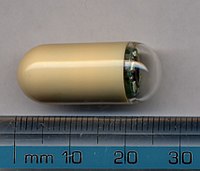
Photo from wikipedia
Background Distinguishing Crohn's disease (CD) and intestinal Behçet's disease (BD) is difficult in clinical practice. Aim To evaluate the ability of CT enterography (CTE) to enhance the diagnostic value of… Click to show full abstract
Background Distinguishing Crohn's disease (CD) and intestinal Behçet's disease (BD) is difficult in clinical practice. Aim To evaluate the ability of CT enterography (CTE) to enhance the diagnostic value of endoscopy in differentiating CD from intestinal BD and to establish differential diagnosis models. Methods A total of 113 patients with CD and 70 patients with intestinal BD from seven tertiary inflammatory bowel disease centers were enrolled. The univariate and multivariate analyses were used by SAS software version 9.2. Three differential scoring models based on the multivariate analysis of endoscopic features alone (model 1), endoscopic features combined with clinical symptoms (model 2), and endoscopic features combined with clinical symptoms and CTE (model 3) were established. Results The results showed that model 2 increased the efficacy of model 1 in differential diagnosis and model 3 had the highest accuracy of 84.15% at a cutoff value of two points. The scoring of model 3 was as follows: genital ulcer (−3 points), skin lesions (−3 points), oval ulcer (-2 points), longitudinal ulcer (1 point), number of ulcers > 5 (3 points), inflammatory polyps (2 points), mucosal severe enhancement (2 points), and fibrofatty proliferation (1 point). Conclusion Clinical symptoms and CTE increased the ability of endoscopy to differentiate CD from intestinal BD.
Journal Title: Frontiers in Medicine
Year Published: 2022
Link to full text (if available)
Share on Social Media: Sign Up to like & get
recommendations!